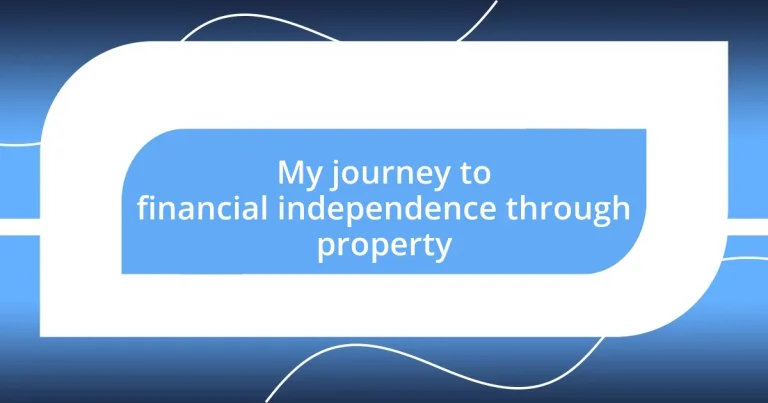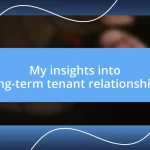Key takeaways:
- Financial independence is a mindset shift focused on living life on one’s own terms through strategic investments and effective budgeting.
- Setting clear and personalized financial goals helps turn aspirations into actionable steps, making the journey feel more achievable.
- Building and managing a diversified property portfolio, along with networking and educating oneself, are crucial for mitigating risks and enhancing passive income streams.
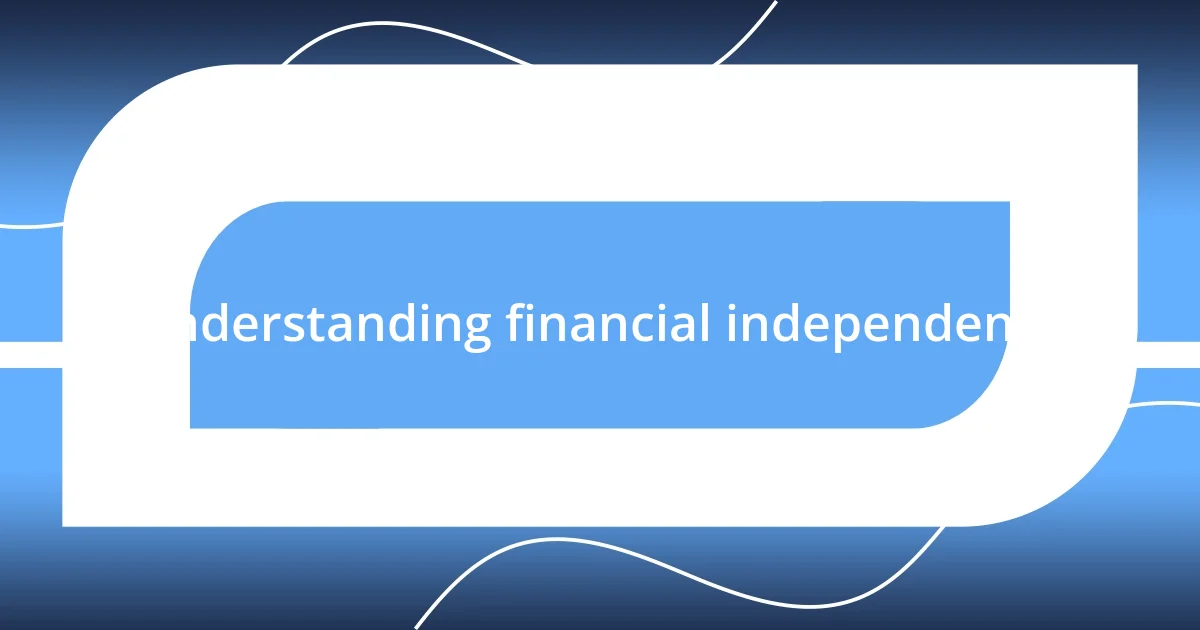
Understanding financial independence
Understanding financial independence is about more than just having enough money; it’s a mindset change. I remember the moment I realized this—sitting on my couch, overwhelmed by the bills scattered around me. I wondered, “What does true freedom feel like?” It hit me that financial independence isn’t merely a number in the bank; it’s the ability to live life on my own terms.
As I started mapping out my journey, I found that financial independence involves creating streams of income that work for me. I transformed my perspective from viewing money as a limitation to seeing it as a tool for freedom. It’s empowering to know that with strategic investments and smart budgeting, I can generate wealth and security, allowing me to focus on the things I truly love.
Sometimes, I ponder the sacrifices I made along the way—saying no to extravagant vacations and honing my spending habits. Yet, each sacrifice felt like a step closer to my ultimate goal. Can you imagine the weight lifting off your shoulders when you realize you’re not just working for a paycheck, but building a life? That realization was pivotal for me, sparking a commitment to my financial journey that I carry with enthusiasm to this day.
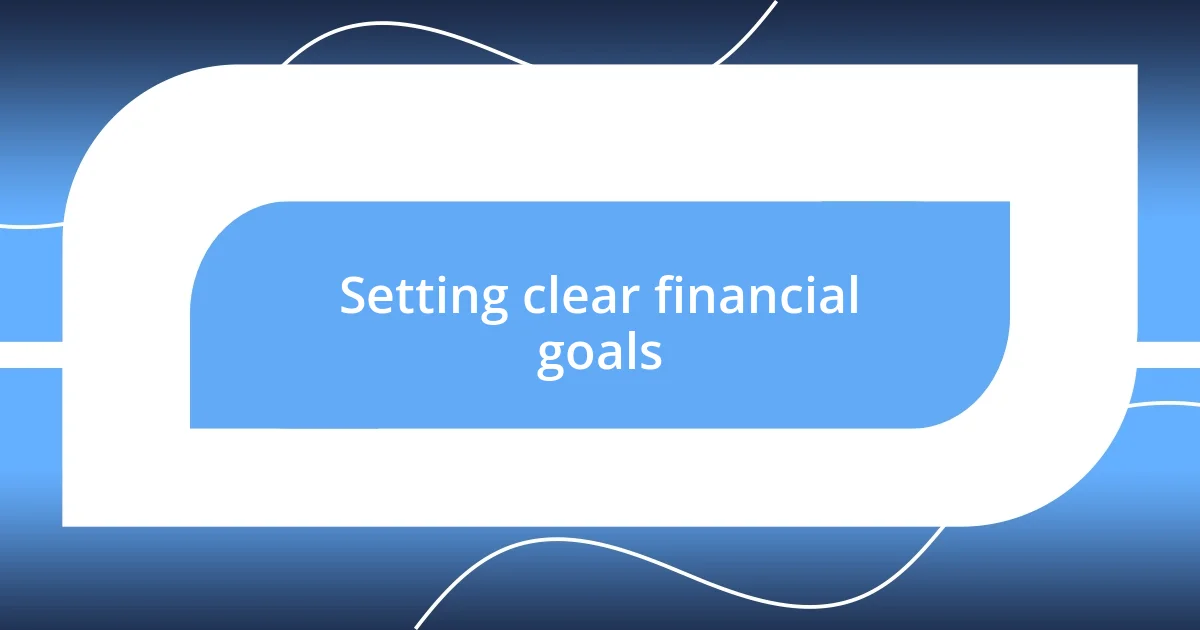
Setting clear financial goals
Setting clear financial goals is crucial for charting your path to independence. I recall the first time I sat down with a notepad, feeling both excited and overwhelmed. I wrote down my aspirations, from buying my first rental property to achieving a specific income level. It was a mixture of hope and reality—an emotional rollercoaster where I had to face my current financial situation while dreaming of my future. Having tangible targets made my journey feel less daunting and more achievable.
Here are a few steps I found helpful in setting my financial goals:
- Define what financial independence means to you: This personalizes the journey.
- Break down larger goals into smaller, manageable tasks: I started with saving a certain amount each month.
- Set specific deadlines: For instance, I aimed to purchase my first property within two years.
- Revise goals regularly: Life changes, and so should your goals. Reassessing them kept me aligned and motivated.
- Celebrate milestones along the way: Achieving small victories, like reaching a savings target, fueled my drive and confidence.
By identifying what I truly wanted and committing to a plan, I transformed uncertainty into actionable steps, and that made all the difference in my financial journey.
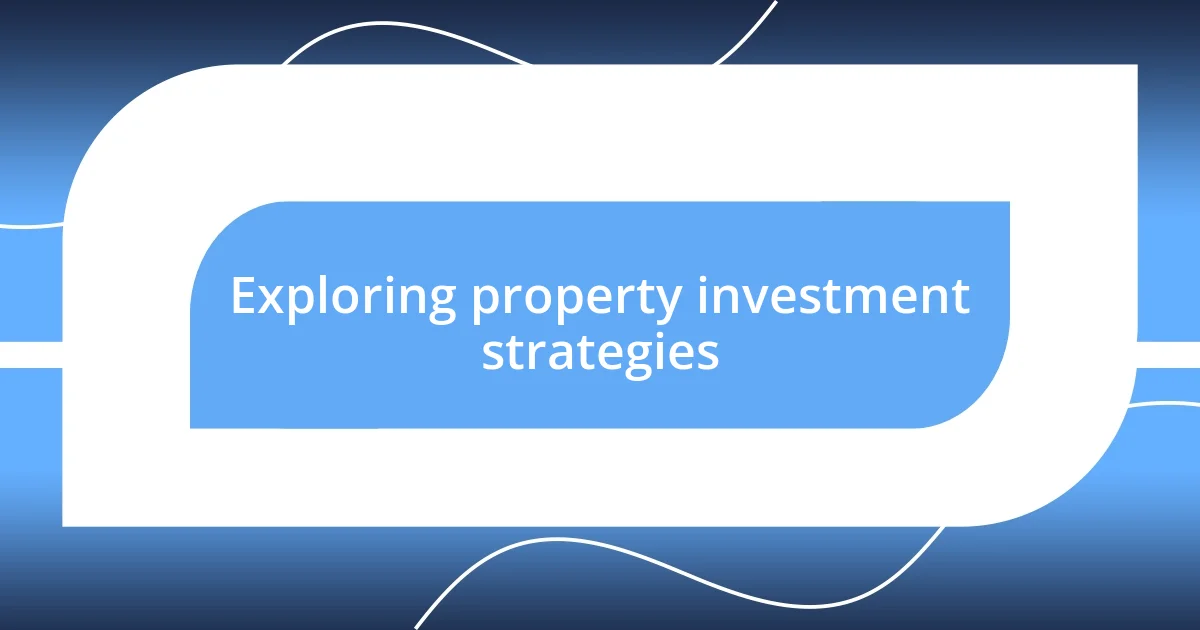
Exploring property investment strategies
When I first delved into property investment strategies, I was curious about the various approaches available. It quickly became clear that each strategy had its distinct advantages and challenges. For instance, investing in rental properties felt appealing because of the potential for steady cash flow, which I found comforting—a consistent check each month really takes the pressure off. On the other hand, flipping houses intrigued me with its allure of quick profits, but I realized that it also involves significant risk, like unexpected renovation costs that can easily eat into potential gains.
Moreover, I started comparing the long-term benefits of buy-and-hold strategies versus more active strategies like house hacking—where you live in one part of the property while renting out another. I was hesitant at first to share my living space, but once I embraced that approach, I discovered the thrill of building equity while reducing my own living expenses. This combination of personal growth and economic insight enriched my investment journey in ways I hadn’t anticipated.
As I explored these various strategies, I also found that networking with other investors expanded my understanding. Hearing their success stories and challenges painted a fuller picture of what to expect. Engaging with fellow investors reminded me that it’s all about learning and evolving through shared experiences, and that camaraderie has been invaluable. It’s not merely a solo journey; we thrive on each other’s insights and lessons learned along the way.
| Investment Strategy | Pros |
|---|---|
| Rental Properties | Steady cash flow, long-term appreciation |
| Flipping Houses | Potential for quick profits, ideal for those seeking short-term gains |
| Buy-and-Hold | Builds equity over time, lower stress |
| House Hacking | Reduces living expenses, creates passive income |
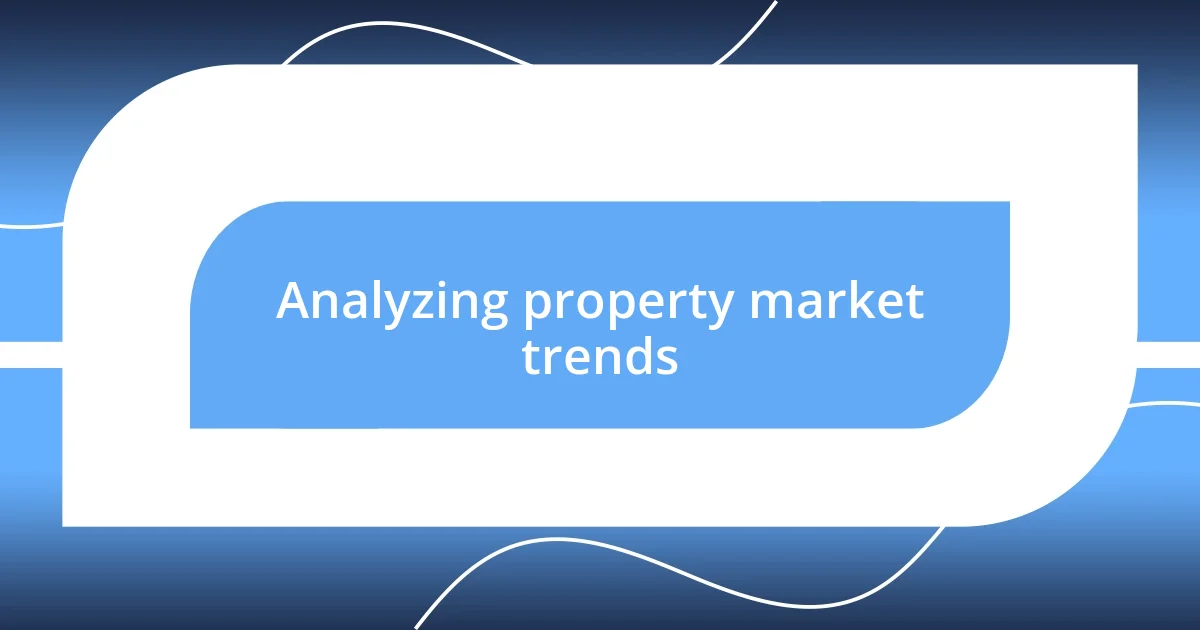
Analyzing property market trends
Analyzing property market trends has been instrumental in guiding my investment decisions. I vividly remember poring over historical data and charts, searching for patterns that could hint at future movements. It felt like piecing together a puzzle; each trend revealed something new, whether it was the impact of interest rate changes or shifts in buyer demographics. Have you ever noticed how external factors, like economic growth or local events, can suddenly reshape the market landscape? I certainly have, and it highlighted for me how crucial it is to stay informed and adaptable.
I found that keeping an eye on emerging neighborhoods was a game changer. During my journey, I stumbled upon an up-and-coming area that was showing early signs of revitalization, and I felt a rush of excitement. It was an opportunity that not many had yet recognized, and I knew I had to act quickly. Sometimes, it’s all about being in the right place at the right time—something I learned through diligent market analysis. I often wonder, what if I hadn’t trusted my instincts and done that research? Would I have missed out on a golden opportunity?
Beyond just statistics, I learned to appreciate the emotional pulse of the market. Conversations with local real estate agents and residents opened my eyes to the underlying sentiments; people’s attitudes towards an area often reflected its desirability. Engaging directly with the community gave me insights that numbers alone couldn’t provide. This blend of hard data and human insight became my secret weapon in spotting profitable investments. In my experience, being attuned to both the figures and the feelings creates a holistic approach that truly pays off.
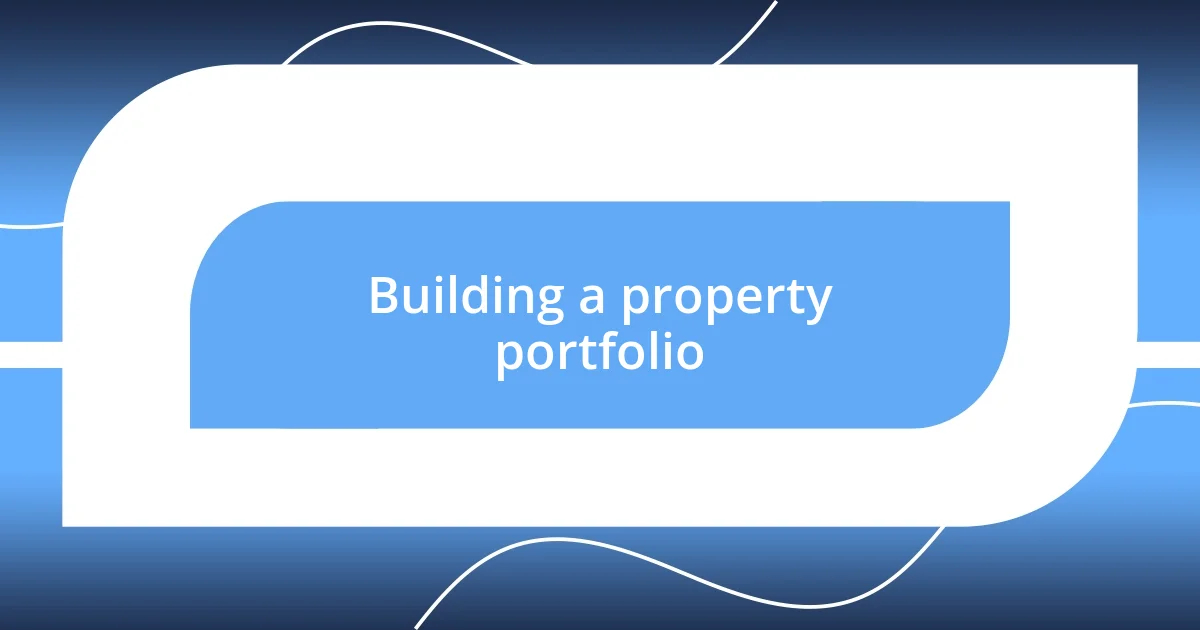
Building a property portfolio
Building a property portfolio is much like nurturing a garden; it requires patience, diligence, and a keen eye for potential. I remember my first purchase vividly—it was a modest two-bedroom house that needed some TLC. I could feel that spark of excitement mixed with trepidation, questioning whether I was stepping into a solid investment or diving into a financial black hole. But as I rolled up my sleeves and got to work, I learned that every effort, every risk taken, added to the overall richness of my investment journey.
As my portfolio expanded, I soon realized the importance of diversification. I branched out from residential properties to include a small commercial unit, which, at first, felt intimidating. Did I have enough knowledge to manage a different type of tenant with varying needs? Surprisingly, the experience taught me invaluable lessons about lease negotiations and market demands, enriching my overall understanding of real estate. Have you ever stepped into unfamiliar territory and emerged more skilled? That’s how I felt every time I embraced a new property type.
Moreover, I’ve discovered that building relationships in this journey is just as critical as the properties themselves. Establishing connections with local contractors, property managers, and other investors has opened doors I never anticipated. There were moments when I leaned on their advice during tough renovations or market downturns, and those bonds turned out to be just as valuable as the bricks and mortar I was investing in. I often find myself asking, what would my portfolio look like today if I hadn’t built that network? It’s a thought that reminds me of the power of collaboration in achieving financial independence.
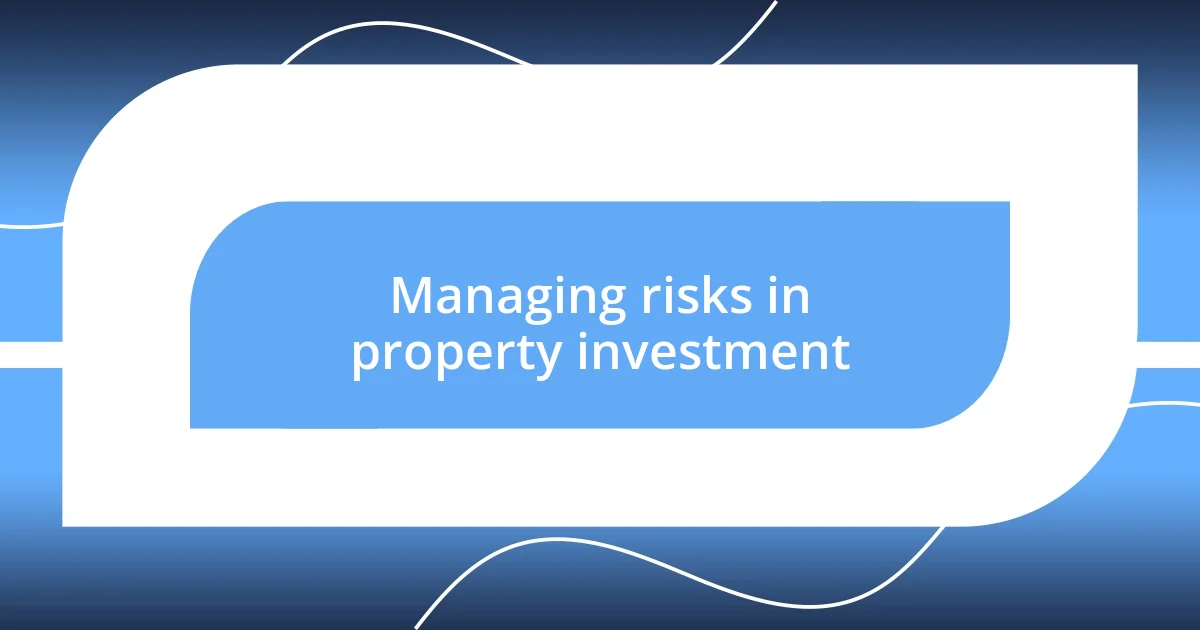
Managing risks in property investment
Risk is an inherent part of property investment, but it doesn’t have to be daunting. One experience I recall was when I faced an unexpected vacancy in one of my rental units. My first instinct was panic; I worried about cash flow and potential maintenance costs. However, this moment taught me about the importance of having a financial buffer. I suggest creating a reserve fund to cushion against such surprises—it’s a safety net that can turn your anxiety into confidence when challenges arise. Does knowing you have that support in place help you sleep better at night? It certainly does for me.
While embracing risk is part of the journey, educating myself became my best defense. I remember attending a local property investment workshop where I immersed myself in discussions about insurance options and tenant screening strategies. I realized that knowledge is power, and developing a comprehensive understanding of market fluctuations, property laws, and insurance policies can significantly minimize risks. How much time do you invest in learning about your assets? I’ve found that the more I know, the less I worry, allowing me to make informed decisions with ease.
Lastly, I’ve come to appreciate the value of a thorough property inspection. On one occasion, I nearly passed on a promising deal because the surface seemed perfect, but I insisted on a detailed check. It revealed underlying plumbing issues that could have led to costly repairs. Making due diligence a regular part of my process isn’t just smart—it’s essential. I often ask myself, what would the outcome have been if I hadn’t taken that extra step? It reinforces the idea that managing risks isn’t just about limiting exposure; it’s about being proactive and informed every step of the way.
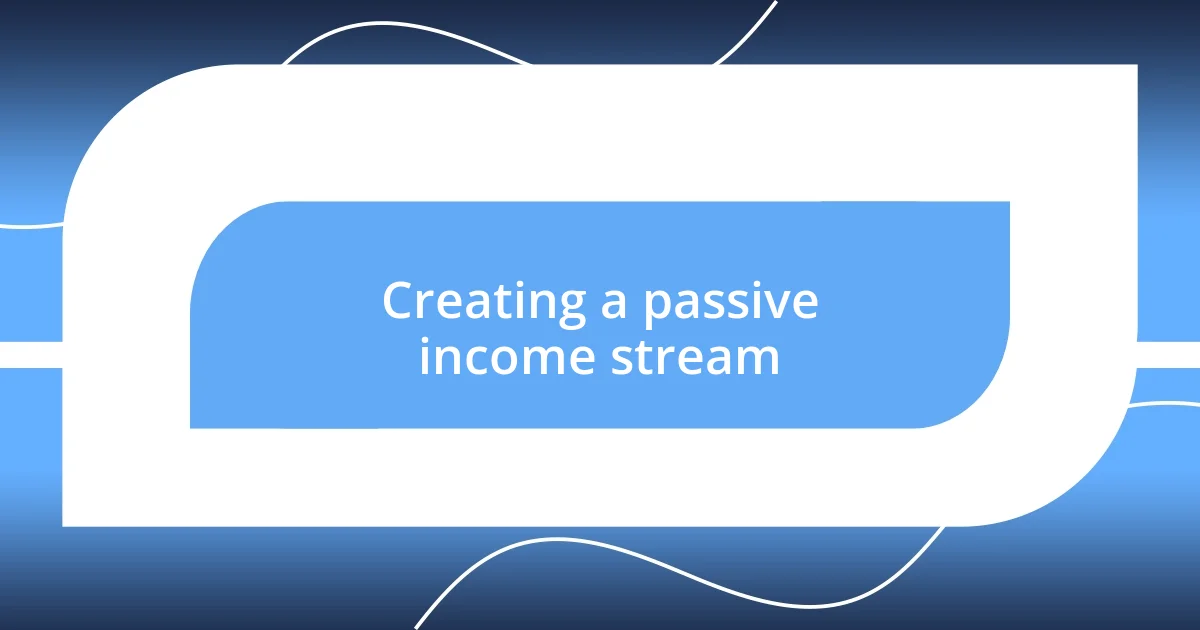
Creating a passive income stream
Creating a passive income stream through property has been one of my most rewarding experiences. I still remember the first time I received my rental income—it was exhilarating! That small check not only contributed to my financial goals but also solidified my belief that I was on the right path. Have you ever felt that rush when a plan finally pays off? It’s one of the best feelings.
I quickly learned that diversification in property types can significantly enhance passive income. When I added a few short-term rental units to my portfolio, I was surprised at how the income potential changed. Each unit told its own story and attracted different guests, which brought a fresh excitement every season. I often find myself wondering, what if I hadn’t embraced the short-term rental market? The thought reminds me that being open to new avenues can multiply profits in unexpected ways.
Building a strong management system has also been key in creating a reliable income stream. Initially, I tried to handle everything myself, from tenant communication to maintenance issues. It was overwhelming! Once I hired a property management service, I was amazed at how much smoother everything ran. Suddenly, I had time back for myself while my investment worked diligently. Have you ever felt the immense relief of delegating responsibilities? I know I did, and it made all the difference in enjoying the journey toward financial independence.












